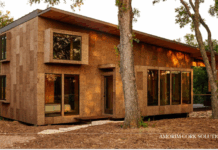
By Peter Thompson, general manager of ISO-CHEMIE UK
THE more airtight we make our buildings the less fresh air is able to penetrate through unwanted gaps, creating issues for people with respiratory problems or young children among other problems – so proper ventilation is crucial.
‘Build Tight, Vent Right’ has been a popular building design mantra, particularly to those concerned with the Fabric First strategy, rather than just throwing ‘Eco Bling’ at a building design to achieve the relevant Standard Assessment Procedure credentials.
It is often argued that if by reducing air loss you then need to build-in designed ventilation, then why bother in the first place?
The answer, apart from legislative compliance, is control. It is the difference between controlled air loss, or ventilation, and uncontrolled air loss and draughts, which is the nub of the whole issue.
How is ‘Build Tight, Vent Right’ achieved? With regards to ventilation, this generally falls into two major camps: natural and mechanical ventilation.
If you achieve an air loss of 3m3 (h.m2) @50Pa or less, then it is a necessity to use mechanical ventilation.
With an air loss of more than 3m3 (h.m2), it is considered that well designed natural ventilation is sufficient for most domestic dwellings.
For unwanted air loss, it is acknowledged that the air loss between the junctions of windows and doors to walls, walls to floors and walls to ceilings accounts for more than 50% of the air loss in a house.
Other common factors of air loss relate to fabric of the building itself and the various holes knocked through the fabric for an assortment of reasons such as drainage, heating flues, electrical cables etc.
There are products on the market claiming to be airtight seals but the key is to use the correct ones in the right environment, and consider how they might degrade over time.
Furthermore, if a requirement of airtightness is to reduce heat loss out of the building, then thermal resistance to these air leak sources needs to be considered as well. Being airtight will reduce or stop heat loss by convection, but what about heat loss by conduction, often referred to as non-repeating thermal bridges?
The industry is starting to understand that airtightness is only half the story for the sealants, which is why the thermal insulation of joints between window, doors and walls is included in the latest SAP calculations, after previously being ignored.
The requirements necessary to create a long term solution must be considered when choosing an airtight seal. If it’s to seal the edges or overlaps of an internal airtight membrane, then movement and thermal insulation are unlikely to be factors to consider. However, when sealing an actual construction joint between similar or different materials, it is a different story.
An illustrative example is the movement between joints created by the junction of different construction materials, such as windows to walls or walls to roof etc. In this respect, while the differential movement between timber frame buildings and the external masonry facades is well documented, the different coefficient of expansion factors of different materials is less well known.
When selecting a suitable airtight seal for this type of application, installers must consider several factors to assess if it is correct for the type of joint to be sealed, based on:
• The need to accommodate movement.
• Any need to allow for conduction heat loss, to maintain the thermal integrity of the abutting materials.
• The suitability of the active adhesive system for both initial application and long term use on the substrate.
• The potential for harmful emissions from the sealing materials and adhesives, and their effect on internal air quality must also be assessed.
An airtight seal therefore needs to be more than just an adhesive tape. At first glance, tapes might all look like they perform the same or a similar function but there are many performance variables meaning some products are more suited than others – in the same way as timber frame construction methods are not all identical or suitable for certain situations.











